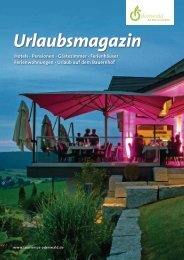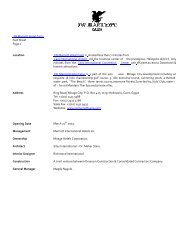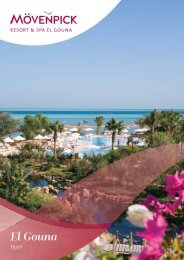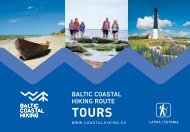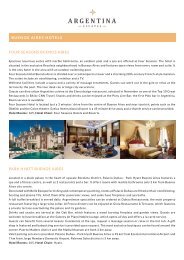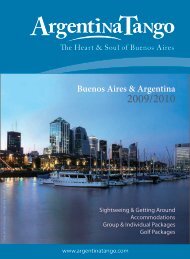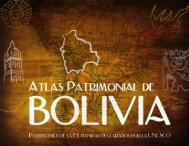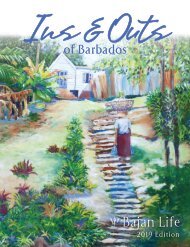Travel guide
Create successful ePaper yourself
Turn your PDF publications into a flip-book with our unique Google optimized e-Paper software.
Namibia <strong>Travel</strong><br />
Planning Guide<br />
WELCOME TO NAMIBIA<br />
Climb the highest sand dunes in the world. Descend to the floor of the deepest canyon in Africa.<br />
Immerse yourself in the past at one of the Africa’s richest rock art sites, and watch wildlife shimmer<br />
against one of the most spectacular pans on earth. Explore the oldest, driest desert in the world and<br />
take time to listen to the silence and to your soul.<br />
Namibia is home to vibrant cities where people are excited about the future, while remaining deeply<br />
connected to their rich, cultural past. A stable, democratic government, infrastructure that allows guests<br />
to move confidently off the beaten path and endless horizons that beckon you to explore define this<br />
country and its people.<br />
This is Namibia, where you are sure to find adventure, and you may just find yourself.
When to Go<br />
Namibia has 300 days of sunshine a year and each season has its<br />
unique qualities, so there really is no bad time to visit! Summers<br />
(Jan-March) are hot and fairly damp with average maximum<br />
temperatures around 25–35°C (77-95°F) and average minima<br />
around 10–20°C (50-68°F). On a typical day during the rains,<br />
you will have blues skies in the morning and by early afternoon<br />
the clouds will appear. In the late afternoon there will be an<br />
hour’s torrential rain on some days. Such tropical storms are<br />
spectacular and everything feels terrifically fresh afterwards. By<br />
May the rains have generally ceased, with abundant sunshine<br />
and the summer’s plants still lush and green. Typical winters<br />
(June-August) have average maximum temperatures of around<br />
15–25°C (59-77°F) and the average minima are around 0–10°C<br />
(32-50°F). That said you will still find yourself wearing shorts<br />
and a T-shirt during the day, and getting sunburnt if you are not<br />
careful. Clouds will be a rare sight for the next few months and<br />
sunsets are spectacular. By September the green vegetation has<br />
completed faded and the heat begins to return.<br />
For Game Viewing<br />
Namibia has the big 5!<br />
For a predominately arid country which is predominately arid,<br />
Namibia boasts one of the greatest wildlife populations in the<br />
world, some species are truly unique, many are rare, and a<br />
few whose lineage goes back long before the first ancestors of<br />
mankind evolved.<br />
In the Etosha National Park, huge herds of springbok, gemsbok,<br />
zebra, and blue wildebeest, as well as smaller numbers of red<br />
hartebeest, Bruchell’s zebra, lion, cheetah and the elusive<br />
leopard gather at waterholes and are spotted easily against the<br />
stark white background immense salt pans. Waterberg Plateau<br />
was proclaimed to nurture small numbers of endangered animals<br />
– different species of antelope, buffalo, white rhino and many<br />
more. Cape Cross on the Skeleton Coast represents one of the<br />
largest seal reserves in the world. These three parks represent<br />
the most popular wildlife attractions in Namibia, but others dot<br />
the entire country – all experiencing a renaissance of sorts thanks<br />
to a massive internationally recognized conservation effort.<br />
The end of the dry season (between July and October) is generally<br />
the best time to see big game. It is then, as the small bush pools
dry up and the green vegetation shrivels, the animals move closer<br />
to the springs or the waterholes and rivers.<br />
During and after the rains, it is unlikely to see much game, partly<br />
because the lush vegetation hides the animals, and partly because<br />
most of them will have moved away from the waterholes (where<br />
they are most easily located) and gone deeper into the bush.<br />
For Bird Watching<br />
The rainy season (October to April) is the best time for birding.<br />
The last few months of the year witness the arrival of the summer<br />
migrant birds from the north, anticipating the coming of the<br />
rains. In the lush Caprivi Strip, you’ll find exotic lilac-breast rollers,<br />
pygmy geese and African Jacanas. When the rains are good, the<br />
natural pans in Etosha and Bushmanland will fill with aquatic bird<br />
species, including huge numbers of flamingos.<br />
For Hiking<br />
The best time for hiking is during the cooler months (April-<br />
October). Note that most of the long trails in the national parks<br />
are closed between November and March. The popular Fish<br />
River Canyon Hiking Trail can be undertaken only from April 15 to<br />
September 15.<br />
Getting There<br />
By Air<br />
From Europe<br />
Only Air Namibia flies directly from Namibia to Europe, with a direct overnight flight seven days a week<br />
between Windhoek and Frankfurt.<br />
The time difference between Western Europe and Namibia is either an hour or two hours depending on the<br />
season, so there’s no jet lag.<br />
Air Namibia also operates connecting flights to/from Johannesburg and Cape Town to link up with most<br />
intercontinental flights to/from Windhoek. From London, travellers can connect to Air Namibia via Frankfurt<br />
or use one of the major carriers to Johannesburg (11 hours), and then connect through to Windhoek. If you<br />
consider flying via Johannesburg, then there are a whole host of other options, from many European airports.<br />
British Airways and South African Airways have frequent services, and both operate add-on connections to<br />
Windhoek, run by their subsidiaries.
From the Americas<br />
South African Airways operates direct flights from Dulles International Airport in Washington, DC and J F<br />
Kennedy International Airport in New York, NY to Johannesburg. They also have direct flights to Johannesburg<br />
from Atlanta, GA, codesharing with Delta. From Johannesburg there are numerous regional flights to Windhoek.<br />
Air Namibia offers services from Accra, Ghana to Windhoek, connecting with Delta/American codeshares to<br />
the U.S. Canadian and U.S. citizens should be aware they require visas to transit through Ghana. Alternatively,<br />
many travellers from the US approach southern Africa using connections via Europe, joining Air Namibia’s<br />
flights in Frankfurt, or travelling on one of the many carriers servicing Johannesburg, and then connecting<br />
through to Windhoek. Given the duration of these flights, travellers often include a few days in Europe as they<br />
transit.<br />
<strong>Travel</strong>lers in Central and South America might use the Atlanta or European gateways, or the direct flights from<br />
São Paulo or Buenos Aires to Johannesburg, run by South African Airways.<br />
From Elsewhere<br />
From the Far East, there are flights between Johannesburg and most of the major centres in the region,<br />
including Hong Kong (with South African Airways or Cathay Pacific) and Singapore (South African Airlines and<br />
Singapore Airlines). From Australasia, the best route is probably one of the flights from Perth to Johannesburg,<br />
with South African Airways or Qantas, connecting to Windhoek.<br />
By Land<br />
If you are not flying in, then entering over one of Namibia’s land borders is equally easy. . If you are crossing with<br />
a hired car, then remember to let the car-hire company know, as they will need to provide you with the right<br />
paperwork before you set off.<br />
Road-user charges have been imposed to generate sufficient funding to maintain a safe and economically<br />
efficient road sector in Namibia. Cross-Border Charges (CBCs) or Entry Fees to be paid by all foreign-registered<br />
vehicles entering the country amount to N$220.00 per vehicle, N$140.00 for a trailer, motorcycle or caravan,<br />
and buses either N$520.00 or N$660.00, depending on the number of axles.<br />
Tourists driving privately owned vehicles and foreign-registered rental vehicles are required to pay CBCs, for<br />
Namibia / South Africa<br />
Ariasmsvlei: open 24hrs<br />
Noordoewer: open 24hrs<br />
Oranjemund / Alexander Bay: 06H00-<br />
22H00<br />
Rietfontein: 08H00 – 16H30<br />
Hohlweg: 08H00 – 16H30<br />
Velloordrift / Onseepskans: 08H00 –<br />
17H00<br />
BORDER CROSSING HOURS<br />
Ngoma Bridge: 07H00 – 18H00<br />
Muhembo/ Shakawe: 06H00 – 18H00<br />
Buitepos / Mamuno: 07H00 – 24H00<br />
Namibia / Angola<br />
Ruacana: 08H00 – 18H00<br />
Omahenene: 08H00 – 18H00<br />
Oshikango: 08H00 – 18H00<br />
Rundu: 08H00 – 18H00<br />
Namibia / Botswana<br />
Impalila Island: 07H00 – 18H00<br />
Namibia / Zambia<br />
Wanele / Sesheke: 06H00 – 18H00
which a CBC certificate will be issued for every entry into Namibia. The fees vary between the types of vehicle.<br />
Permits for regular road users travelling within 10 km of a designated border post will be issued at the discretion<br />
of the RFA (Road Fund Administration) at a cost of N$310.00. These permits will be valid for three months or 30<br />
crossings.<br />
Cash payments can be made in Namibia dollars at all border posts or designated payment offices, while creditcard<br />
payments can be effected at all border posts except Ruacana/Omahenene. Prepayment options are<br />
available at Ariamsvlei, Noordoewer, Buitepos, Katima Mulilo and<br />
Oshikango. Please note that these fees are subject to change.<br />
How to <strong>Travel</strong><br />
Visitors can travel through the country by means of scheduled tours in luxury coaches or microbuses, by train,<br />
fly-in safaris, self-drive tours, off-the-beaten-track camping trips in 4x4 vehicles, specialised tailor-made tours,<br />
wilderness safaris, safaris on horseback, canoeing and white-river rafting. Specialist tailor-made tours for birdwatchers,<br />
geologists, anglers, ethnologists, photographers and other specialist travellers are <strong>guide</strong>d by experts<br />
in the respective fields.<br />
Self-Drive<br />
Self-drive trips are excellent for travellers who like to have some<br />
flexibility in their itinerary and explore places off the beaten path.<br />
All you need is a reliable vehicle, an international driver’s license,<br />
a good map and a good sense of adventure. Namibia has good<br />
infrastructure and friendly people and the combination lends<br />
itself to self-exploration. The country has a vast, well-maintained<br />
road network with international links to South Africa, Botswana,<br />
Zimbabwe and Zambia, cell phone coverage that spans the<br />
entire country and accommodation that varies from community<br />
campsites to 5 star luxury. English is the official language, so North<br />
Americans and most Europeans find the country easy to navigate<br />
and with the locals. You can connect with other travellers visiting<br />
Namibia here.
How to choose a vehicle<br />
CARAN, the Car Rental Association of Namibia, is a non-profit association of 18 members that was established to<br />
protect tourists and the car-rental industry against sub-standard service. Car-rental companies must subscribe<br />
to minimum standards before they are accepted as members of the association. Below are some important<br />
factors to consider when renting a vehicle:<br />
• 4WD vehicles cost more to hire and run, but have good ground clearance and are normally fitted with tyres<br />
that are better suited to Namibia’s roads.<br />
• 2WD vehicles have less ground clearance and carry less.<br />
• 2WD camping cars come equipped with everything you’ll need.<br />
• 4WD camping cars come equipped with everything you’ll need and are more versatile than normal sedans<br />
or other two-wheel-drive vehicles equipped for camping.<br />
• Motor homes are usually better suited to tarred roads as they tend to be top heavy and have poor ground<br />
clearance.<br />
Group Tours<br />
Another option is to take a <strong>guide</strong>d group tour around the country. These trips are suitable for travellers who<br />
feel more comfortable having a <strong>guide</strong> take care of logistical issues such as planning the route, driving and<br />
setting up accommodations. They also suit single travellers as they provide ready-made companions. These<br />
tours vary in price and design, so that some are ideal for travellers looking to have gain local knowledge of a<br />
destination without having to do extensive research while others are suited for specialist travellers seeking<br />
expert knowledge of the area.<br />
Fly-Ins<br />
Fly-In safaris are an option for travellers with a flexible budget and limited time in Namibia. Small private charter<br />
flights can be arranged to all points within the country, including many of the smaller lodges and guest farms.<br />
It’s a very easy way to travel. It is also the only way to get to some of the more inaccessible corners, like the<br />
northern section of the Skeleton Coast. Fly-In safaris can also be combined with overland trips. The majority<br />
of fly-in operators agree that the most popular scenic flights are to Sossusvlei, famous for its magnificent starshaped<br />
red and orange dunes, and day trips to authentic Himba villages in the north-western part of Namibia.
The following companies offer personalised fly-in safaris:<br />
• Skeleton Coast Fly-In Safaris<br />
• Wings Over Africa<br />
• Desert Air<br />
• Wilderness Air<br />
• African Profile Safaris<br />
• Scenic Air<br />
Accommodations<br />
Hotels & Lodges<br />
Most visitors choose to stay in lodge style accommodation while<br />
travelling in Namibia, but the country also has a range of hotels.<br />
The choices vary from rustic country hotels to large luxury hotels<br />
in the major town such as Windhoek and Swakopmund. Bush<br />
camps and lodges are available at various price levels, and often<br />
have a distinct feel and atmosphere.<br />
Guest Farms<br />
Guest farms are private farms, which host small numbers of<br />
guests and offer a very personal experience. Guests will often<br />
dine with the hosts and be taken on excursions by them during<br />
the day. Most have some wildlife on their land and conduct their<br />
own game drives. Many guest farms cater to German-speaking<br />
visitors. As space in these establishments is limited, they should<br />
usually be booked in advance.<br />
Camping<br />
Namibia is a camper’s paradise. There is a wide choice of sites all<br />
over Namibia for seasoned campers or nervous novices on their<br />
first camping holiday, from luxury campsites under shady trees<br />
and grassy lawns, to wild places under a camel-thorn tree in a<br />
sandy riverbed. In the more remote areas, far from settlements,<br />
it is perfectly acceptable to just sleep by the road.<br />
In recent years, there has been a growth in the number of<br />
community campsites. These campsites, especially in the<br />
northwest and north-east of the country, have stylishly natural<br />
designs, and have been built with material from the area.<br />
Community campsites provide a base from which to enjoy and<br />
explore the highlights of the country and magnificent scenery,<br />
while offering opportunities to meet the various and interesting<br />
ethnic groups of Namibia, eat local food, visit local homesteads,<br />
make new friends and experience new cultures.
Organizing Your Trip<br />
Tour Operators<br />
Destination Specialist<br />
Although many operators sell trips to Namibia, there are a select few who truly know the country well. Tour<br />
operators who have qualified as a Namibia Destination Specialist have demonstrated expert knowledge in<br />
Namibia’s array of products and offerings. We highly recommend that you consider planning your trip with a<br />
Destination Specialist. To find a specialist near you click here:<br />
Namibia Holiday & <strong>Travel</strong><br />
The Namibian Holiday & <strong>Travel</strong> is the Official Namibian Tourism Directory. The publication offers extensive<br />
information to help travellers plan their trip and serves as an invaluable source for self-drive travellers planning<br />
their own itinerary. A copy of the 2012 publication can be downloaded here.<br />
Tourist Information<br />
Visas & Entry<br />
Foreign nationals must be in possession of a passport that is valid for at least six months after date of entry.<br />
Passports should also contain a minimum of 6 blank pages. A visa is required from all visitors except nationals<br />
of countries with which Namibia has the necessary visa abolition agreement. No visas are required for<br />
South African passport holders travelling as bona fide tourists. All other South African citizens require visas,<br />
for instance when travelling to Namibia for business reasons. Holidaymakers and tourists are welcome to<br />
remain in the country for a period of 90 days. Business visas are granted at the discretion of the immigration<br />
authorities. It should be noted that immigration officials have the authority to grant duration of stay, which is<br />
to be based on the information provided on the arrival form, and tourists are advised to check their passports<br />
and documentation to ensure that the visa granted matches the duration of stay intended. Tourist visas can be<br />
obtained from the Ministry of Home Affairs, at Namibian embassies and the NTB office in Cape Town. Please
note that visas cannot be obtained from points of entry. Visas can be extended and applications for extension<br />
of visas granted must be submitted to any Home Affairs Office, with prescribed fees applying.<br />
If visitors to Namibia have a tourist/holiday visa, they are not allowed to engage in any employment while in the<br />
country. Should they wish to do so, they should apply for an employment permit in their country of residence<br />
prior to entry. The same applies for study permits.










